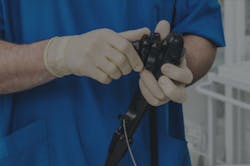Spotting warning signs about cleaning effectiveness
What are some of the most and least obvious warning signs your endoscopic equipment has not been cleaned properly and shouldn’t be sent to high-level disinfection or sterilization? Sterile processing experts share their insights.
Let’s start with the MOST obvious – or visible – ones
Crit Fisher, Director, Field Ops, Protection1, KARL STORZ Endoscopy-America Inc.
While there are five basic steps to reprocessing that must be completed in order — cleaning, high-level disinfection (HLD), rinsing, drying and storage — it all begins with effective cleaning. Failure to fully clean the device of residue can render each successive step ineffective. Among the most visible displays of improper or incomplete cleaning are:
- Appearance of residue or film on the proximal and distal window of the endoscopes.
- Pitting of the surface of the instrument.
- Signs of corrosion.
- Discoloration or browning of the light fibers.
- Visible bioburden inside the working channels of instrumentation.
- Instrumentation parts or components that stick, such as jaws that do not open and close smoothly.
- Moisture under the eyepiece of a flexible or rigid endoscope.
- Cuts in the bending rubber of a flexible endoscope.
- Stretched out bending rubber that creates excessive material at distal tip of a flexible endoscope.
Steve Jenson, Senior Product Manager, STERIS Corp.
- Observation of discoloration of your HLD chemistry during soaking (Note: This may also be seen when changing from an aldehyde to oxidative HPC/LCS).
- Going against known best practices, standards and IFUs, such as using a sink of detergent solution for multiple scopes, flushing prior to (but not after) brushing channels, etc.
- Cleaning verification test results indicate the presence of residual soil.
- The HLD is failing sooner than expected (organic loads can cause some HLD chemistries to degrade faster). This might indicate a more systemic problem versus limited occurrences.
- Ryan Klebba, Vice President, Endoscopy Sales Division, STERIS Instrument Management Services, IMS/Synergy Health, a subsidiary of STERIS plc.
- Inadequate inventory of scopes will force users to hurry to reprocess scopes in order to meet procedural demand. This can result in poor cleaning practices.
- Dirty field lenses on the distal end of the scope.
- Bioburden remaining on scopes for too long after the procedure making it very difficult to clean due to dried bioburden.
- Any obvious debris remaining on the scope after high level disinfection or sterilization.
- Failed ATP testing/protein testing.
Robert B. Dybec, RN, MS, CPSN, CNOR, EMT-B, Nurse Manager, Operating Room Winthrop-University Hospital, Mineola, NY, and Clinical Consultant, Ruhof Corp.
The most obvious sign that an endoscope has not been properly cleaned is the clear visible sign of bioburden that has been left on a scope while doing a visual inspection.
Some additional signs include items such as:
- No available documentation that the scope was cleaned.
- No visual reference that a scope is clean such as a tag or container which displays a “clean” symbol.
- No documentation that a verification process for manual cleaning, such as an ATP test, was performed or a positive test that indicates an unclean or poorly cleaned scope.
- No records of a leak test being performed (this is a critical step in the cleaning process).
- Mary Ann Drosnock, MS, FAPIC, CIC, CFER, RM (NRCM), Manager, Clinical Education for Endoscopy, Healthmark Industries
- Visible residual debris left on the exterior of the endoscope is an obvious sign of inadequate cleaning. This requires that the endoscope be inspected thoroughly after manual cleaning prior to disinfection.
- A positive (failing) result on a cleaning verification test, such as a protein, hemoglobin or carbohydrate test, is a warning sign that the endoscope hasn’t been properly cleaned.
- Visible debris in the channel of the endoscope upon inspection with a borescope is an obvious sign of improper cleaning.
- Not following the validated cleaning instructions for the scope can easily result in an inadequately cleaned instrument. These steps are not meant to be abbreviated or changed and yet they often are.
- Failure to follow the latest guidance from AAMI found in ST91 and your professional society recommendations, such as SGNA or AORN, can lead to an improperly cleaned scope. The latest research and recommendations are incorporated into these guidelines and thus they contain the most up-to-date information. Therefore, a failure to follow the latest information contained in these guidelines, could put your facilities behind the curve as to what the latest research states is required to properly clean an endoscope.
Brianne Flesher, Flexible Scope Division Manager, Mobile Instrument Service & Repair Inc.
- Debris/bioburden present in the distal end around lenses and c-cover.
- Scope accessories still attached to the scope, such as air/water buttons and biopsy port covers, indicating they were not removed during the cleaning process.
- Unpleasant odors remaining after cleaning.
- Bioburden emitting from scope.
- Rapid biological indication testing with positive microorganism results.
And here are some of the LEAST obvious – or hidden – ones
Crit Fisher, KARL STORZ Endoscopy-America Inc.
Less prominent signs of improper or incomplete cleaning may include:
- Damage to the working channel caused by using an incorrect cleaning brush on that part of the scope.
- Bioburden left behind due to the light post adapters not being removed from the endoscope during the cleaning process.
- Debris inside a rigid endoscope as a result of flashing the scope. The expansion and rapid cooling can cause the rod lenses to rub against the spacers, fracturing the lenses or rubbing the spacers.
Steve Jenson, STERIS Corp.
- Single-use consumable inventories (sponges, brushes, chemistry) are not depleting at the same rate as the case load.
- Re-use of gloves from scope to scope.
- Using the incorrect brush size for channels. A brush with too small of a diameter may not maintain sufficient contact with internal walls of channels.
- Skipping the rinse step.
- Using cold water for washing and/or rinsing.
Robert B. Dybec, RN, Winthrop-University Hospital and Ruhof Corp.
The least obvious warning signs are not obvious at all. This is where the cleaning process, and more importantly, the adherence to standards, policies or recommended practices comes in to play. Some of the things that we would not see include:
- Short cuts taken by cleaning personnel in order to save time.
- Proper dilution ratios of enzymatic cleaners not being used.
- Temperature parameters not met.
- Wrong size or overused brushes being used.
- Human error or lack of education. No accountability.
- Not following manufacturers IFUs.
- Improper or false documentation.
- Not verifying manual cleaning practices.
It is extremely important for every nurse or technician to understand the importance of proper cleaning and following current practices. Initial education followed by ongoing competencies is crucial as well as auditing of the personnel and processes in place.
Mary Ann Drosnock, Healthmark Industries
- Not performing any cleaning verification testing on scopes may result in an improperly cleaned endoscope. Cleaning verification testing at regular intervals is now recommended by AAMI ST91, AORN, and SGNA. Yet many facilities still don’t perform any such testing and are not even aware of the recommendations. Cleaning verification provides feedback on whether your scopes have been adequately cleaned. If your facility isn’t performing cleaning verification at regular pre-established intervals, then you do not have any feedback mechanism to tell you how your facility is doing for cleaning. Therefore, an inadequately cleaned scope could sneak by and go onto disinfection or sterilization.
- A scope that has had a delay of more than one hour in between pre-cleaning and manual cleaning is at risk of not being properly cleaned. These scopes need extra attention and facilities should have a protocol in place to deal with delays in processing.
- An endoscope that has not been properly leak-tested is at risk of not being cleaned properly. If a scope is damaged and fails leak test, there is a risk of retained patient fluids and cleaning chemistries, which can lead to improper cleaning and an infection control risk.
- Not performing pre-cleaning on an endoscope immediately after the procedure and thoroughly in accordance with the manufacturer’s IFU can result in an improperly cleaned endoscope.
- Suction is a validated step in the cleaning process for certain endoscope manufacturers. If this is not performed as recommended, then a scope may not be adequately cleaned. Consult your endoscope reprocessing manual to determine whether your scope requires suction during the manual cleaning process.
- Endoscope cleaning brushes are meant to be used on a single scope. Single-use brushes or reusable brushes are appropriate. But, if using reusable brushes, they should not be reused between cases without themselves being cleaned and disinfected or sterilized. Many facilities are still using the same brush between different scopes and this is not proper technique. If using single-use brushes, they must be disposed of after cleaning one scope.
- Many facilities will use the same model of brush for all of their scopes. The endoscope manual needs to be consulted to determine which type of brush needs to be used. If not using the exact model of brush that is recommended by the endoscope manufacture, then facilities need to make sure that the brush that they are using matches the specifications of what is recommended. Many brush manufacturers make this a simple process. Consult the endoscope IFU and the brush manufacturer’s information to ensure a proper match.
Brianne Flesher, Mobile Instrument Service & Repair Inc.
- Bioburden present in the internal walls of the working/biopsy channel.
- Cleaning tool remnants still present on scope such as brush bristles and sponge particles.
- Using expired rapid biological indication testing kits that can result in false negative test result.
- Moisture present inside of scope after appropriate drying/hang time has transpired.
- Difficulty in passing cleaning brush through the suction port of the scope down through the distal end after cleaning as this channel is sometimes overlooked.
Adam Peck, Senior Director of Marketing, CenTrak
A lack of visibility into your facility’s infection control procedures could present hidden warning signs that your endoscopes are sometimes not cleaned properly.
- For example, if you have no way of knowing that each step of the reprocessing protocol was successfully completed per regulatory standards (manual decontamination, leak testing, high-level disinfection, rinsing, drying) and one step of this process fails, there is an increased risk of infection transmission.
- Additionally, if you are unsure how long a scope has remained idle after use, this could cause bioburden to set and harden increasing the chance of inadequate cleaning as scopes are to enter the initial stage of the reprocessing cycle within one hour to avoid stubborn bacteria.
- Storage conditions are also very important. Endoscopes should be hung vertically in a clean, well-ventilated cabinet with ambient temperature and relative humidity between 30 percent and 60 percent. Temperature and humidity levels that fall out of this range for too long could create scope contamination.
- Failure to prioritize asset utilization and consistently using the same scope – resulting in frequent and unnecessary reprocessing – could be damaging to the endoscope, making it unsafe for patient use.
- It is also important to remember that you may have a very well-oiled plan for reprocessing the majority of your scopes that are used in the G.I. suite, but that is not the only place that scopes are used. It is not uncommon to have a less fail-proof process in place for scope used in the OR, ED, DI, ICU, etc. All too often scopes that are used in these ancillary areas do not reach the first stage of reprocessing within one hour of use.
About the Author
Rick Dana Barlow
Senior Editor
Rick Dana Barlow is Senior Editor for Healthcare Purchasing News, an Endeavor Business Media publication. He can be reached at [email protected].






